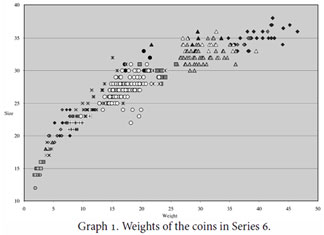The Chronology of Second Century Ptolemaic Bronze Coins:
Two Different Methods to Graphically Interpret Weight/Size Data
An analysis of weight/size data shows that there are serious flaws in a recently presented chronology for 2nd century bronze coinage
A recent study of weights and sizes of second century Ptolemaic bronze coins has presented a new and greatly different chronology for the coins from c.204 to 116 BC. |
|
In contrast, the use of metrological graphing with the same weight data as used in the recent study leads to a chronology that is completely consistent with the previously established and up-to-date attributions of these coins. The well established evaluation of denominations by the use of weight/size is retained and the fiduciary basis of the monetary system in the second century remains the same as that in the third century (and in the first century as well). |
Click here to see a larger image of this weight vs size graph |
||
The two different methods of analysis both begin with the same process: the graphing of sizes versus weights (see the above graph). The methods diverge after this first step; one method (called here "F&L ANALYSIS") assumes that the types (mainly the obverse) of a coin are involved in the determination of denomination, the other method takes the classical fiduciary view that denomination is determined by size and weight ("RP ANALYSIS"). Beginning on this page the F&L method is considered first (as follows). The F&L ANALYSIS of Graph 1 begins; “When the metrological data are placed on a [weight vs size] graph it is possible to discern groups” and these groups “identify ten distinct modules”, i.e., the denominations are identified by weight/size. These groups are the various denominations in the classical cataloguing of second century coins; F&L's Graph 1 illustrates the basic principle that the denominations of these coins are indicated by weight/size. However, it is then stated that “Seemingly these ten modules represent ten bronze denominations, but this perception is somewhat misleading. A classification by module alone overlooks the significance of types and cannot account for the pattern of weight reduction in coins with the types Zeus-Ammon/double-eagle, a combination that appears to have served as a marker for the largest denomination of the system. To gain a better grasp of the denominational system, it is necessary to place the various emissions of Series 6 [the coins in F&L Graph 1 above] in their proper sequence”. The proper sequence was obtained as follows. A “Table of Hoards” was produced that consists of a listing of decreasing average weights/sizes for seven consecutive sub-series of coins with a Zeus-Ammon/double-eagle coin as the first in each series. The positions in the listing are said to be consistent with what is known from fourteen second century hoards that “establish the relative chronology of the series”. By applying the Zeus-Ammon/double-eagle hypothesis of denominational marking by types, the listing is converted to a graph (called here F&L Table 2) that is presented in tabular form; click F&L ANALYSIS (below left) to see this graph. [ If you are impatient to know the final results click on SUMMARY OF RESULTS ]
|
||
Click F&L ANALYSIS to begin a review of F&L's Table 2 |
Click RP ANALYSIS to begin a |
|
|
See F&L ARTICLE ( a pdf of 50 pages) |
See RP ARTICLE (a pfd of 17 pages) |
